Recall of Odorous Objects in Virtual Reality
Abstract
1. Introduction
2. Methods
2.1. Participants
2.2. Odors
2.3. Virtual Objects
2.4. Virtual Reality Environment
2.5. Odor Production and Presentation
2.6. Procedure
2.7. Data Analysis
3. Results
3.1. Recall Accuracy
3.2. Ratings of Valence and Arousal
3.3. Interaction Duration
4. Discussion
5. Conclusions
Author Contributions
Funding
Institutional Review Board Statement
Informed Consent Statement
Data Availability Statement
Conflicts of Interest
References
- Flavián, C.; Ibáñez-Sánchez, S.; Orús, C. The Influence of Scent on Virtual Reality Experiences: The Role of Aroma-Content Congruence. J. Bus. Res. 2021, 123, 289–301. [Google Scholar] [CrossRef]
- Guttentag, D.A. Virtual Reality: Applications and Implications for Tourism. Tour. Manag. 2010, 31, 637–651. [Google Scholar] [CrossRef]
- LaViola, J.J., Jr.; Kruijff, E.; Bowman, D.; Poupyrev, I.P.; McMahan, R.P. 3D User Interfaces: Theory and Practice, 2nd ed.; Addison-Wesley: Hoboken, NJ, USA, 2017. [Google Scholar]
- Serrano, B.; Banos, R.M.; Botella, C. Virtual Reality and Stimulation of Touch and Smell for Inducing Relaxation: A Randomized Controlled Trial. Comput. Hum. Behav. 2016, 55, 1–8. [Google Scholar] [CrossRef]
- Narumi, T.; Nishizaka, S.; Kajinami, T.; Tanikawa, T.; Hirose, M. Augmented Reality Flavors: Gustatory Display Based on Edible Marker and Cross-Modal Interaction. In Proceedings of the 2011 Annual Conference on Human Factors in Computing Systems—CHI ’11, Vancouver, BC, Canada, 7–12 May 2011; ACM Press: New York, NY, USA, 2011; p. 93. [Google Scholar]
- Dmitrenko, D.; Maggioni, E.; Obrist, M. OSpace: Towards a Systematic Exploration of Olfactory Interaction Spaces. In Proceedings of the 2017 ACM International Conference on Interactive Surfaces and Spaces, Brighton, UK, 17–20 October 2017; ACM: New York, NY, USA, 2017; pp. 171–180. [Google Scholar]
- Holloman, A.K.; Crawford, C.S. Defining Scents: A Systematic Literature Review of Olfactory-Based Computing Systems. ACM Trans. Multimed. Comput. Commun. Appl. 2022, 18, 1–22. [Google Scholar] [CrossRef]
- Maggioni, E.; Cobden, R.; Dmitrenko, D.; Hornbæk, K.; Obrist, M. SMELL SPACE: Mapping out the Olfactory Design Space for Novel Interactions. ACM Trans. Comput. Hum. Interact. 2020, 27, 1–26. [Google Scholar] [CrossRef]
- Wang, Y.; Amores, J.; Maes, P. On-Face Olfactory Interfaces. In Proceedings of the 2020 CHI Conference on Human Factors in Computing Systems, Honolulu, HI, USA, 25–30 April 2020; ACM: New York, NY, USA, 2020; pp. 1–9. [Google Scholar]
- Baus, O.; Bouchard, S.; Nolet, K. Exposure to a Pleasant Odour May Increase the Sense of Reality, but Not the Sense of Presence or Realism. Behav. Inf. Technol. 2019, 38, 1369–1378. [Google Scholar] [CrossRef]
- Baus, O.; Bouchard, S. Exposure to an Unpleasant Odour Increases the Sense of Presence in Virtual Reality. Virtual Real. 2017, 21, 59–74. [Google Scholar] [CrossRef]
- Carulli, M.; Bordegoni, M.; Cugini, U. Visual-Olfactory Immersive Environment for Product Evaluation. In Proceedings of the 2015 IEEE Virtual Reality (VR), Arles, France, 23–27 March 2015; Volume 2, pp. 161–162. [Google Scholar]
- Hopf, J.; Scholl, M.; Neuhofer, B.; Egger, R. Exploring the Impact of Multisensory VR on Travel Recommendation: A Presence Perspective. In Information and Communication Technologies in Tourism 2020; Springer International Publishing: Cham, Switzerland, 2020; pp. 169–180. [Google Scholar]
- Jung, S.; Wood, A.L.; Hoermann, S.; Abhayawardhana, P.L.; Lindeman, R.W. The Impact of Multi-Sensory Stimuli on Confidence Levels for Perceptual-Cognitive Tasks in VR. In Proceedings of the 2020 IEEE Conference on Virtual Reality and 3D User Interfaces (VR), Atlanta, GA, USA, 22–26 March 2020; pp. 463–472. [Google Scholar] [CrossRef]
- Ranasinghe, N.; Eason Wai Tung, C.; Yen, C.C.; Do, E.Y.-L.; Jain, P.; Thi Ngoc Tram, N.; Koh, K.C.R.; Tolley, D.; Karwita, S.; Lien-Ya, L.; et al. Season Traveller: Multisensory Narration for Enhancing the Virtual Reality Experience. In Proceedings of the 2018 CHI Conference on Human Factors in Computing Systems—CHI ’18, Montreal, QC, Canada, 21–26 April 2018; ACM Press: New York, NY, USA, 2018; pp. 1–13. [Google Scholar]
- Covarrubias, M.; Bordegoni, M.; Rosini, M.; Guanziroli, E.; Cugini, U.; Molteni, F. VR System for Rehabilitation Based on Hand Gestural and Olfactory Interaction. In Proceedings of the 21st ACM Symposium on Virtual Reality Software and Technology, Beijing China, 13–15 November 2015; pp. 117–120. [Google Scholar] [CrossRef]
- Brooks, J.; Nagels, S.; Lopes, P. Trigeminal-Based Temperature Illusions. In Proceedings of the 2020 CHI Conference on Human Factors in Computing Systems, Honolulu, HI, USA, 25–30 April 2020; ACM: New York, NY, USA, 2020; pp. 1–12. [Google Scholar]
- Herz, R.S. Emotion Experienced during Encoding Enhances Odor Retrieval Cue Effectiveness. Am. J. Psychol. 1997, 110, 489–505. [Google Scholar] [CrossRef] [PubMed]
- Herz, R.S.; Eliassen, J.; Beland, S.; Souza, T. Neuroimaging Evidence for the Emotional Potency of Odor-Evoked Memory. Neuropsychologia 2004, 42, 371–378. [Google Scholar] [CrossRef] [PubMed]
- Herz, R.S.; Schooler, J.W. A Naturalistic Study of Autobiographical Memories Evoked by Olfactory and Visual Cues: Testing the Proustian Hypothesis. Am. J. Psychol. 2002, 115, 21. [Google Scholar] [CrossRef]
- Kadohisa, M. Effects of Odor on Emotion, with Implications. Front. Syst. Neurosci. 2013, 7, 1–6. [Google Scholar] [CrossRef] [PubMed]
- Zald, D.H.; Pardo, J.V. Emotion, Olfaction, and the Human Amygdala: Amygdala Activation during Aversive Olfactory Stimulation. Proc. Natl. Acad. Sci. USA 1997, 94, 4119–4124. [Google Scholar] [CrossRef] [PubMed]
- Herz, R.S. Are Odors the Best Cues to Memory? A Cross-Modal Comparison of Associative Memory Stimulia. Ann. N. Y. Acad. Sci. 1998, 855, 670–674. [Google Scholar] [CrossRef] [PubMed]
- Dinh, H.Q.; Walker, N.; Song, C.; Kobayashi, A.; Hodges, L.F. Evaluating the Importance of Multi-Sensory Input on Memory and the Sense of Presence in Virtual Environments. In Proceedings of the IEEE Virtual Reality (Cat. No. 99CB36316), Houston, TX, USA, 13–17 March 1999; pp. 222–228. [Google Scholar]
- Spangenberg, E.R.; Crowley, A.E.; Henderson, P.W. Improving the Store Environment: Do Olfactory Cues Affect Evaluations and Behaviors? J. Mark. 1996, 60, 67–80. [Google Scholar] [CrossRef]
- Tortell, R.; Luigi, D.-P.; Dozois, A.; Bouchard, S.; Morie, J.F.; Ilan, D. The Effects of Scent and Game Play Experience on Memory of a Virtual Environment. Virtual Real. 2007, 11, 61–68. [Google Scholar] [CrossRef]
- Ghinea, G.; Ademoye, O.A. Olfaction-Enhanced Multimedia: Bad for Information Recall? In Proceedings of the 2009 IEEE International Conference on Multimedia and Expo, New York, NY, USA, 28 June–3 July 2009; pp. 970–973. [Google Scholar]
- Sabiniewicz, A.; Schaefer, E.; Guducu, C.; Manesse, C.; Bensafi, M.; Krasteva, N.; Nelles, G.; Hummel, T. Smells Influence Perceived Pleasantness but Not Memorization of a Visual Virtual Environment. i-Perception 2021, 12, 204166952198973. [Google Scholar] [CrossRef] [PubMed]
- Moore, A.G.; Herrera, N.S.; Hurst, T.C.; McMahan, R.P.; Poeschl, S. The Effects of Olfaction on Training Transfer for an Assembly Task. In Proceedings of the 2015 IEEE Virtual Reality (VR), Arles, France, 23–27 March 2015; pp. 237–238. [Google Scholar]
- Toet, A.; Van Schaik, M.; Theunissen, N.C.M. No Effect of Ambient Odor on the Affective Appraisal of a Desktop Virtual Environment with Signs of Disorder. PLoS ONE 2013, 8, e78721. [Google Scholar] [CrossRef] [PubMed]
- Mochizuki, A.; Amada, T.; Sawa, S.; Takeda, T.; Motoyashiki, S.; Kohyama, K.; Imura, M.; Chihara, K. Fragra: A Visual-Olfactory VR Game. In Proceedings of the ACM SIGGRAPH 2004 Sketches on—SIGGRAPH ’04, Los Angeles, CA, USA, 8–12 August 2004; ACM Press: New York, NY, USA, 2004; Volume 2004, p. 123. [Google Scholar]
- Errajaa, K.; Legohérel, P.; Daucé, B. Immersion and Emotional Reactions to the Ambiance of a Multiservice Space: The Role of Perceived Congruence between Odor and Brand Image. J. Retail. Consum. Serv. 2018, 40, 100–108. [Google Scholar] [CrossRef]
- Yanagida, Y.; Tomono, A. Basics for Olfactory Display. In Human Olfactory Displays and Interfaces; IGI Global: Hershey, PA, USA, 2013; pp. 60–85. [Google Scholar]
- Salminen, K.; Leivo, J.; Telembeci, A.A.; Lekkala, J.; Kallio, P.; Surakka, V.; Rantala, J.; Isokoski, P.; Lehtonen, M.; Müller, P.; et al. Olfactory Display Prototype for Presenting and Sensing Authentic and Synthetic Odors. In Proceedings of the 2018 on International Conference on Multimodal Interaction—ICMI ’18, Boulder, CO, USA, 16–20 October 2018; ACM Press: New York, NY, USA, 2018; pp. 73–77. [Google Scholar]
- Davelaar, E.J.; Goshen-Gottstein, Y.; Ashkenazi, A.; Haarmann, H.J.; Usher, M. The Demise of Short-Term Memory Revisited: Empirical and Computational Investigations of Recency Effects. Psychol. Rev. 2005, 112, 3–42. [Google Scholar] [CrossRef] [PubMed]
- Glanzer, M.; Cunitz, A.R. Two Storage Mechanisms in Free Recall. J. Verbal Learn. Verbal Behav. 1966, 5, 351–360. [Google Scholar] [CrossRef]
- Poellinger, A.; Thomas, R.; Lio, P.; Lee, A.; Makris, N.; Rosen, B.R.; Kwong, K.K. Activation and Habituation in Olfaction—An fMRI Study. NeuroImage 2001, 13, 547–560. [Google Scholar] [CrossRef] [PubMed]
- Bradley, M.M.; Lang, P.J. Measuring Emotion: The Self-Assessment Manikin and the Semantic Differential. J. Behav. Ther. Exp. Psychiatry 1994, 25, 49–59. [Google Scholar] [CrossRef] [PubMed]
- Bradley, M.M.; Greenwald, M.K.; Petry, M.C.; Lang, P.J. Remembering Pictures: Pleasure and Arousal in Memory. J. Exp. Psychol. Learn. Mem. Cogn. 1992, 18, 379–390. [Google Scholar] [CrossRef] [PubMed]
- Wobbrock, J.O.; Findlater, L.; Gergle, D.; Higgins, J.J. The Aligned Rank Transform for Nonparametric Factorial Analyses Using Only Anova Procedures. In Proceedings of the 2011 Annual Conference on Human Factors in Computing Systems—CHI ’11, Vancouver, BC, Canada, 7–12 May 2011; ACM Press: New York, NY, USA, 2011; Volume 172, p. 143. [Google Scholar]
- Cahill, L.; McGaugh, J.L. Mechanisms of Emotional Arousal and Lasting Declarative Memory. Trends Neurosci. 1998, 21, 294–299. [Google Scholar] [CrossRef] [PubMed]
- LaBar, K.S.; Cabeza, R. Cognitive Neuroscience of Emotional Memory. Nat. Rev. Neurosci. 2006, 7, 54–64. [Google Scholar] [CrossRef] [PubMed]
- McGaugh, J.L.; Cahill, L.; Roozendaal, B. Involvement of the Amygdala in Memory Storage: Interaction with Other Brain Systems. Proc. Natl. Acad. Sci. USA 1996, 93, 13508–13514. [Google Scholar] [CrossRef] [PubMed]
- Phelps, E.A.; LeDoux, J.E. Contributions of the Amygdala to Emotion Processing: From Animal Models to Human Behavior. Neuron 2005, 48, 175–187. [Google Scholar] [CrossRef] [PubMed]
- Delogu, F.; Raffone, A.; Belardinelli, M.O. Semantic Encoding in Working Memory: Is There a (Multi)Modality Effect? Memory 2009, 17, 655–663. [Google Scholar] [CrossRef] [PubMed]
- Goolkasian, P.; Foos, P.W. Bimodal Format Effects in Working Memory. Am. J. Psychol. 2005, 118, 61–78. [Google Scholar] [CrossRef]
- Thompson, V.A.; Paivio, A. Memory for Pictures and Sounds: Independence of Auditory and Visual Codes. Can. J. Exp. Psychol. 1994, 48, 380–398. [Google Scholar] [CrossRef]
- Paivio, A. Mental Representations: A Dual Coding Approach; Oxford University Press: New York, NY, USA, 1986. [Google Scholar]
- Lyman, B.J.; McDaniel, M.A. Memory for Odors and Odor Names: Modalities of Elaboration and Imagery. J. Exp. Psychol. Learn. Mem. Cogn. 1990, 16, 656–664. [Google Scholar] [CrossRef]
- Quak, M.; London, R.E.; Talsma, D. A Multisensory Perspective of Working Memory. Front. Hum. Neurosci. 2015, 9, 1–11. [Google Scholar] [CrossRef] [PubMed]
- Baddeley, A. Human Memory: Theory and Practice; Psychology Press: London, UK, 1997. [Google Scholar]
- Craik, F.I.M.; Tulving, E. Depth of Processing and the Retention of Words in Episodic Memory. J. Exp. Psychol. Gen. 1975, 104, 268–294. [Google Scholar] [CrossRef]
- Morrin, M.; Ratneshwar, S. The Impact of Ambient Scent on Evaluation, Attention, and Memory for Familiar and Unfamiliar Brands. J. Bus. Res. 2000, 49, 157–165. [Google Scholar] [CrossRef]
- Lwin, M.O.; Morrin, M.; Chong, C.S.T.; Goh, S.X. Odor Semantics and Visual Cues: What We Smell Impacts Where We Look, What We Remember, and What We Want to Buy. J. Behav. Decis. Mak. 2016, 29, 336–350. [Google Scholar] [CrossRef]
- Seigneuric, A.; Durand, K.; Jiang, T.; Baudouin, J.-Y.; Schaal, B. The Nose Tells It to the Eyes: Crossmodal Associations between Olfaction and Vision. Perception 2010, 39, 1541–1554. [Google Scholar] [CrossRef] [PubMed]
- Krishna, A.; Lwin, M.O.; Morrin, M. Product Scent and Memory. J. Consum. Res. 2010, 37, 57–67. [Google Scholar] [CrossRef]
- Covaci, A.; Ghinea, G.; Lin, C.-H.; Huang, S.-H.; Shih, J.-L. Multisensory Games-Based Learning-Lessons Learnt from Olfactory Enhancement of a Digital Board Game. Multimed. Tools Appl. 2018, 77, 21245–21263. [Google Scholar] [CrossRef]
- Kwok, R.C.-W.; Cheng, S.H.; Ip, H.H.-S.; Kong, J.S.-L. Design of Affectively Evocative Smart Ambient Media for Learning. In Proceedings of the 2009 Workshop on Ambient Media Computing—AMC ’09, Beijing, China, 23 October 2009; ACM Press: New York, NY, USA, 2009; p. 65. [Google Scholar]
- Tijou, A.; Richard, E.; Richard, P. Using Olfactive Virtual Environments for Learning Organic Molecules. In Proceedings of the International Conference on Technologies for e-Learning and Digital Entertainment, Hangzhou, China, 16–19 April 2006; Volume 3942, pp. 1223–1233. [Google Scholar] [CrossRef]
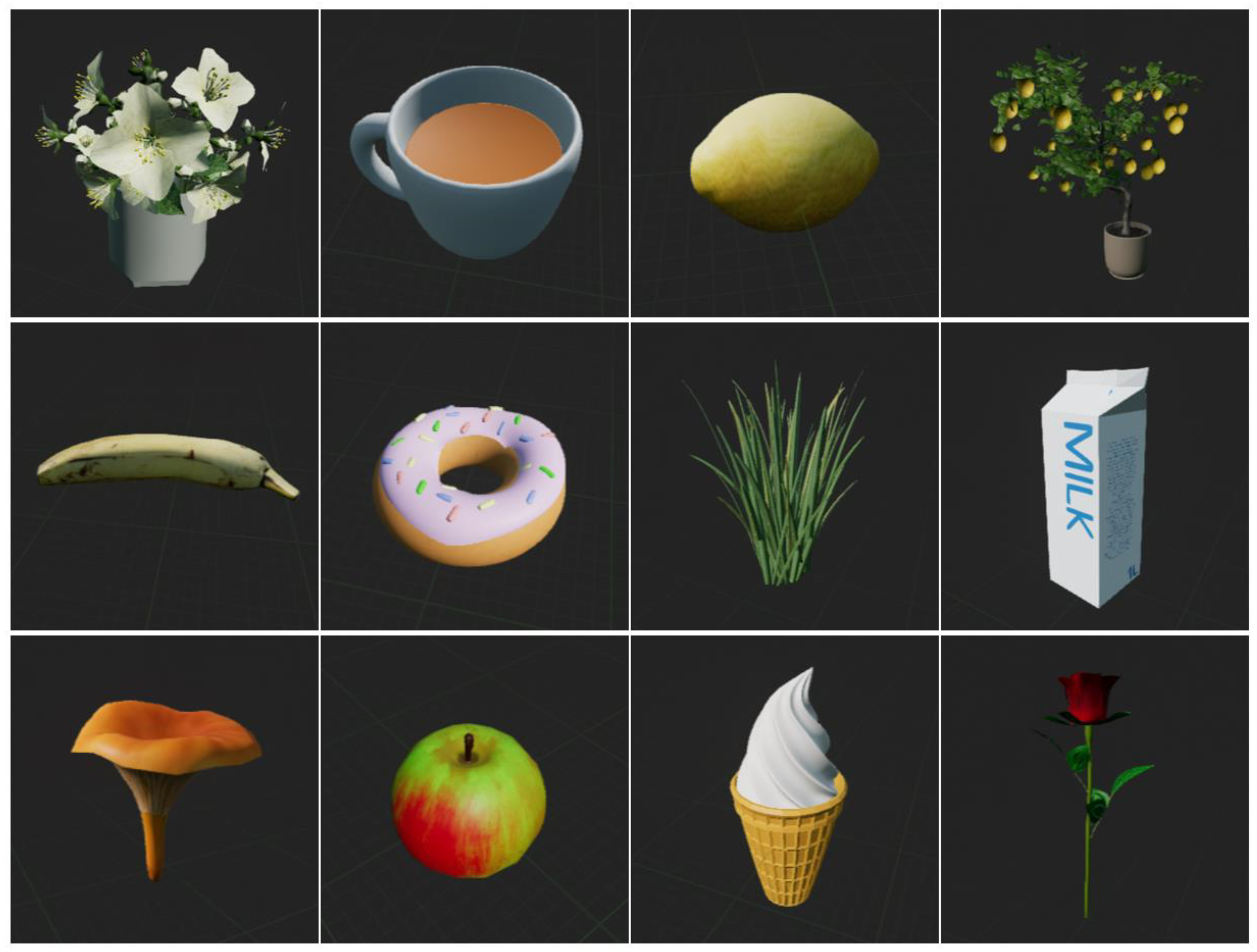
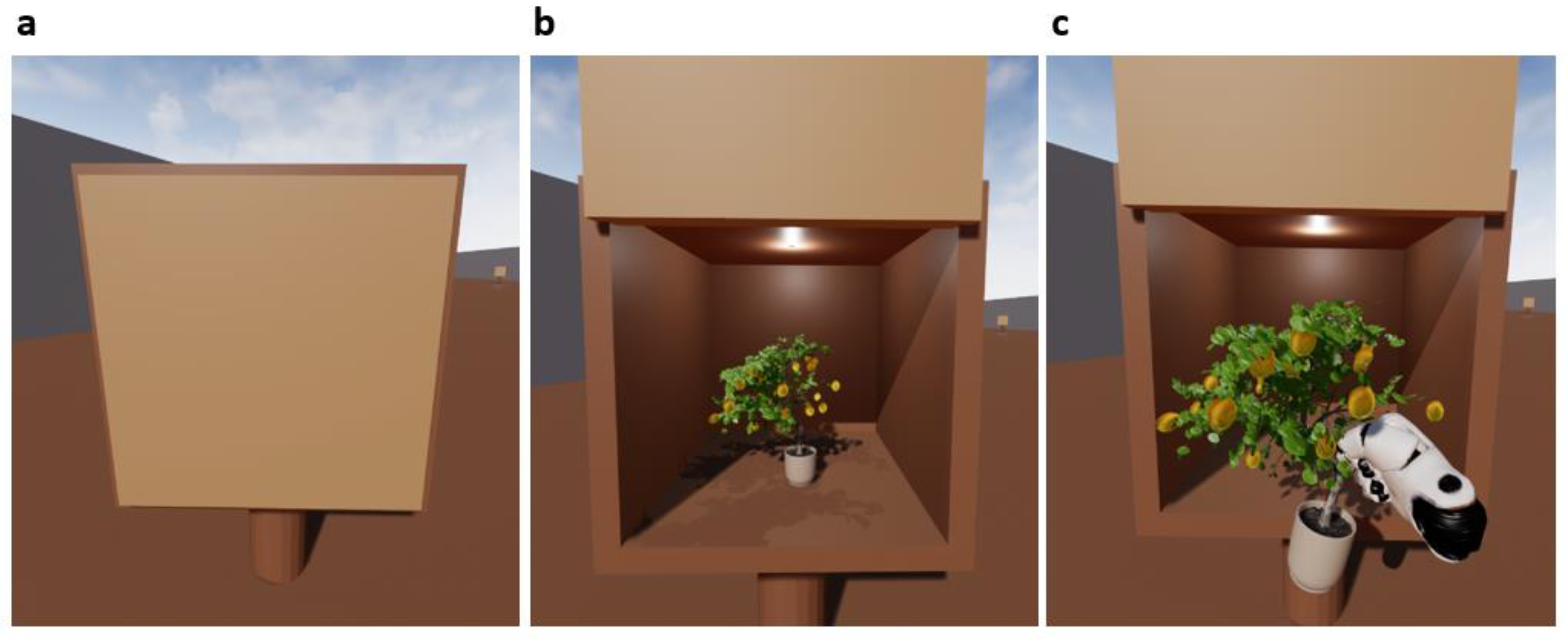
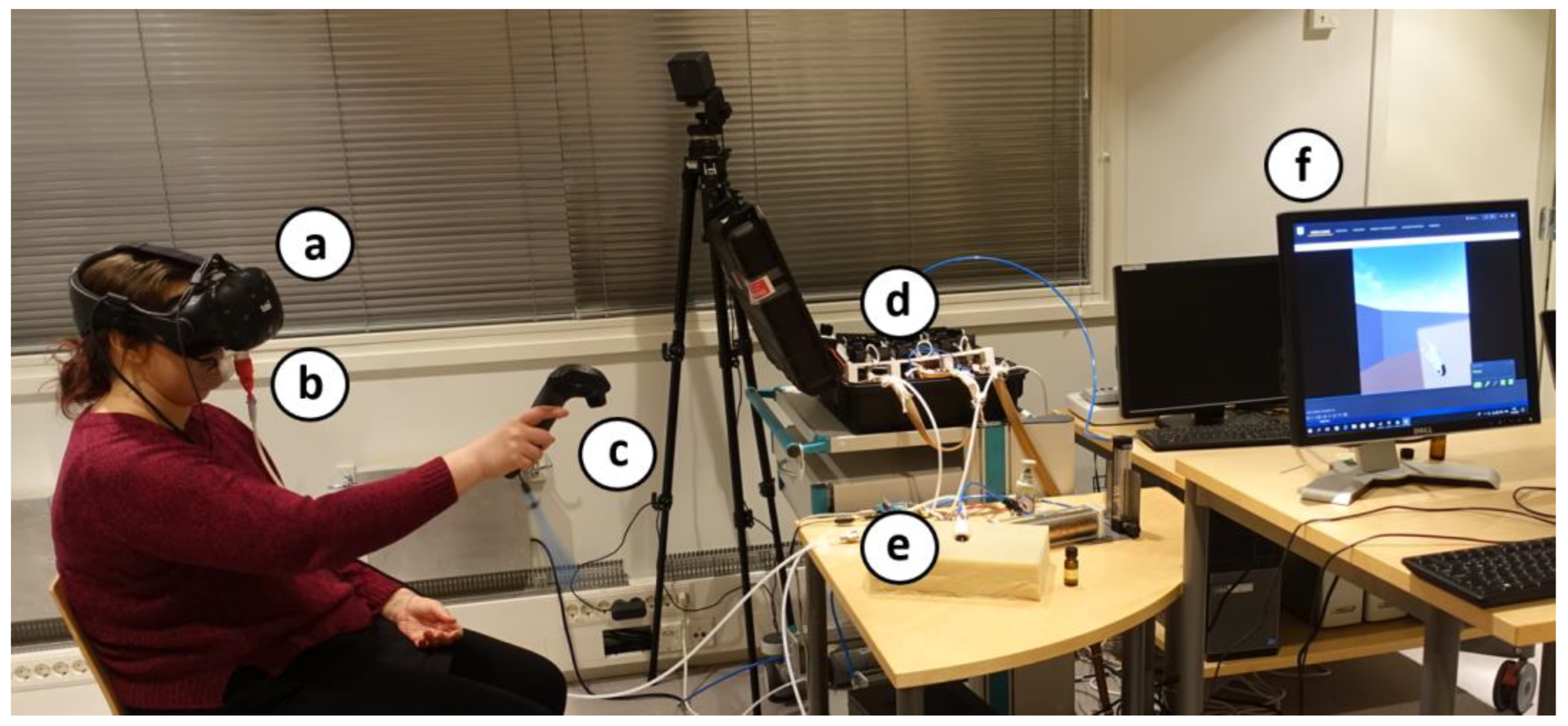

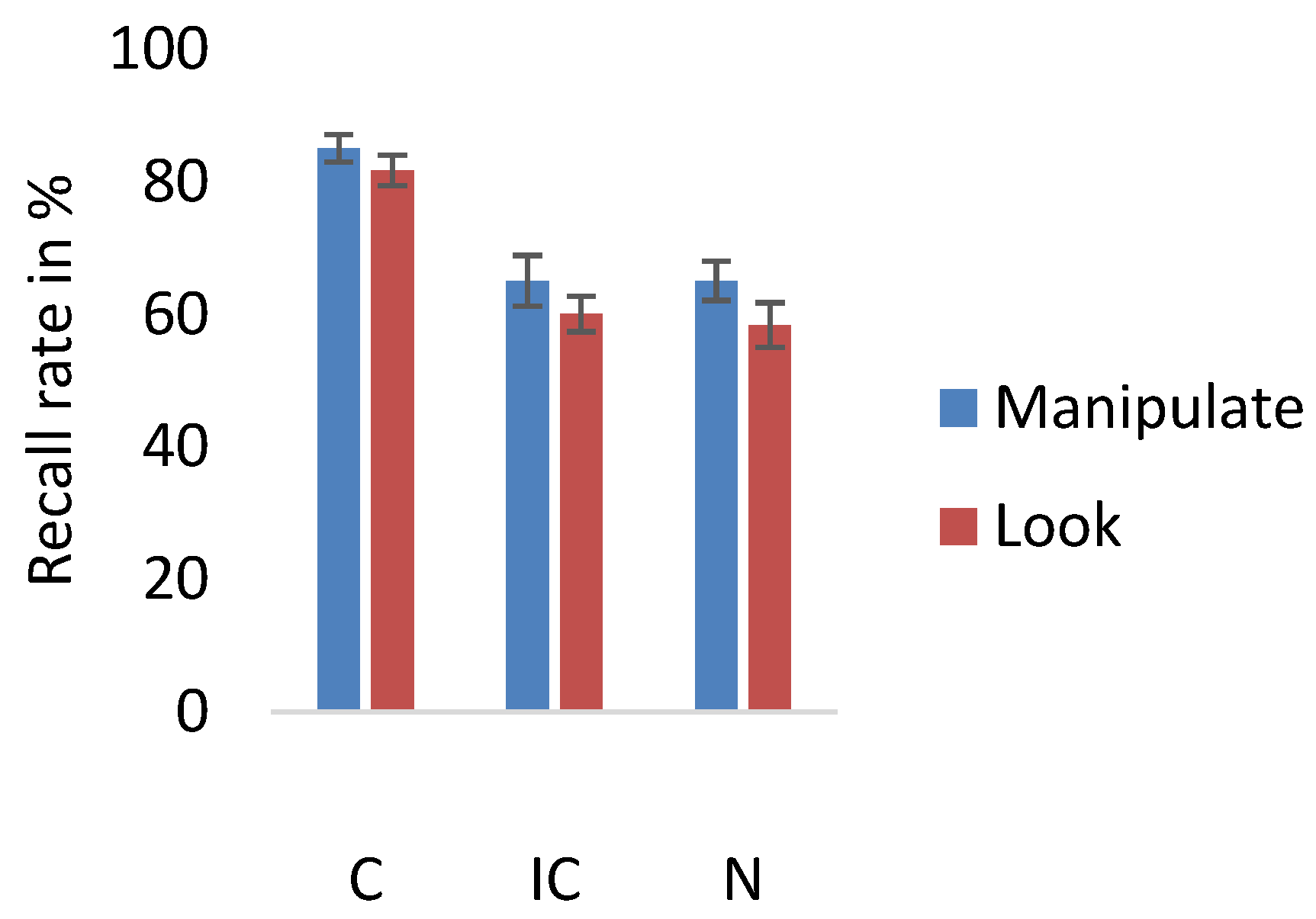
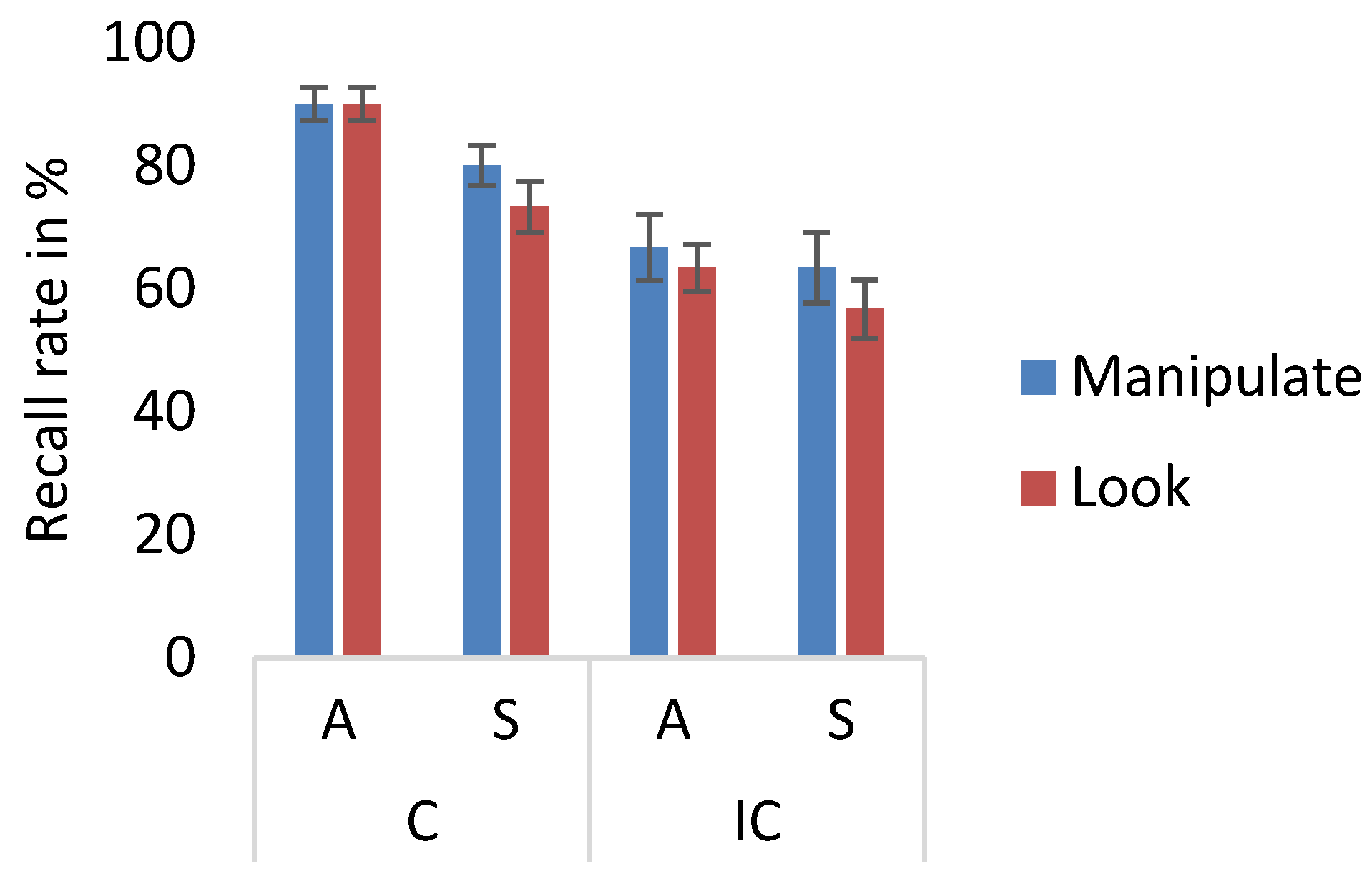
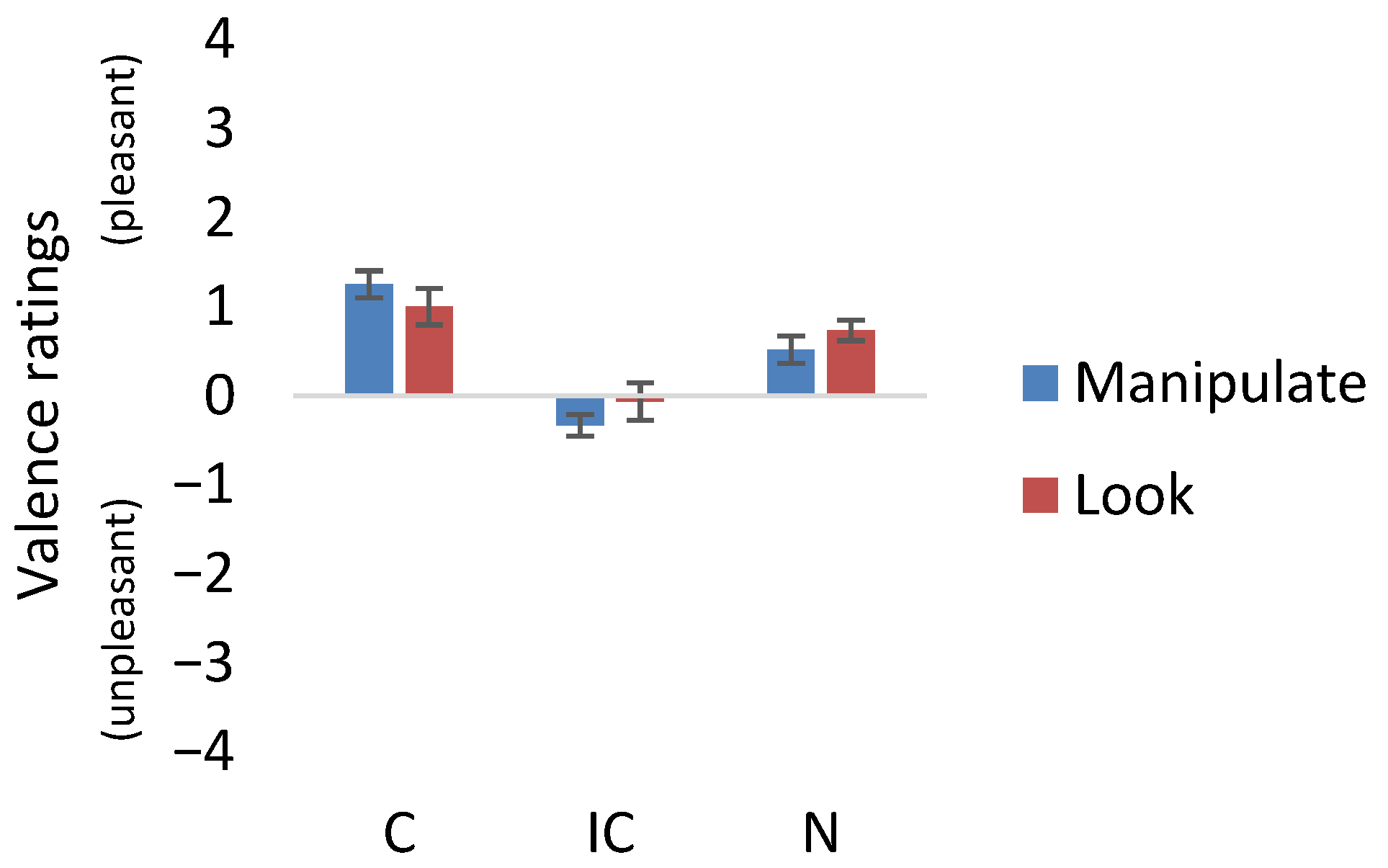
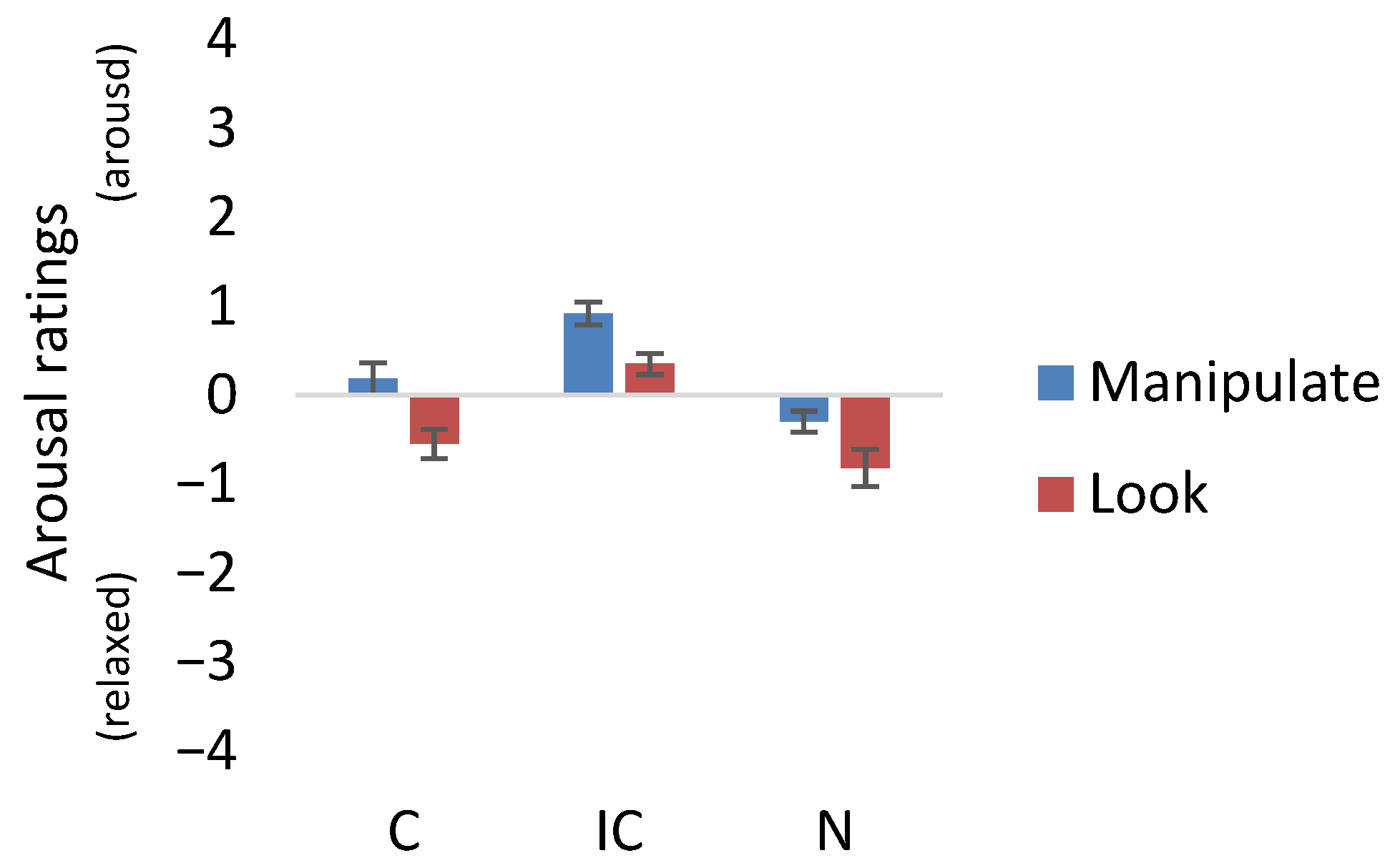
| Box | Object | Odor | Odor–Object Congruence |
|---|---|---|---|
| 1 | Rose | ||
| 2 | Jasmin vase | Authentic jasmine | Congruent |
| 3 | Banana | ||
| 4 | Teacup | Synthetic jasmine | Congruent |
| 5 | Donut | Authentic lemon | Incongruent |
| 6 | Mushroom | Synthetic lemon | Incongruent |
| 7 | Apple | Authentic jasmine | Incongruent |
| 8 | Lemon tree | Synthetic lemon | Congruent |
| 9 | Lemon | Authentic lemon | Congruent |
| 10 | Grass | Synthetic jasmine | Incongruent |
| 11 | Milk | ||
| 12 | Ice cream |
Disclaimer/Publisher’s Note: The statements, opinions and data contained in all publications are solely those of the individual author(s) and contributor(s) and not of MDPI and/or the editor(s). MDPI and/or the editor(s) disclaim responsibility for any injury to people or property resulting from any ideas, methods, instructions or products referred to in the content. |
© 2024 by the authors. Licensee MDPI, Basel, Switzerland. This article is an open access article distributed under the terms and conditions of the Creative Commons Attribution (CC BY) license (https://creativecommons.org/licenses/by/4.0/).
Share and Cite
Rantala, J.; Salminen, K.; Isokoski, P.; Nieminen, V.; Karjalainen, M.; Väliaho, J.; Müller, P.; Kontunen, A.; Kallio, P.; Surakka, V. Recall of Odorous Objects in Virtual Reality. Multimodal Technol. Interact. 2024, 8, 42. https://doi.org/10.3390/mti8060042
Rantala J, Salminen K, Isokoski P, Nieminen V, Karjalainen M, Väliaho J, Müller P, Kontunen A, Kallio P, Surakka V. Recall of Odorous Objects in Virtual Reality. Multimodal Technologies and Interaction. 2024; 8(6):42. https://doi.org/10.3390/mti8060042
Chicago/Turabian StyleRantala, Jussi, Katri Salminen, Poika Isokoski, Ville Nieminen, Markus Karjalainen, Jari Väliaho, Philipp Müller, Anton Kontunen, Pasi Kallio, and Veikko Surakka. 2024. "Recall of Odorous Objects in Virtual Reality" Multimodal Technologies and Interaction 8, no. 6: 42. https://doi.org/10.3390/mti8060042
APA StyleRantala, J., Salminen, K., Isokoski, P., Nieminen, V., Karjalainen, M., Väliaho, J., Müller, P., Kontunen, A., Kallio, P., & Surakka, V. (2024). Recall of Odorous Objects in Virtual Reality. Multimodal Technologies and Interaction, 8(6), 42. https://doi.org/10.3390/mti8060042







